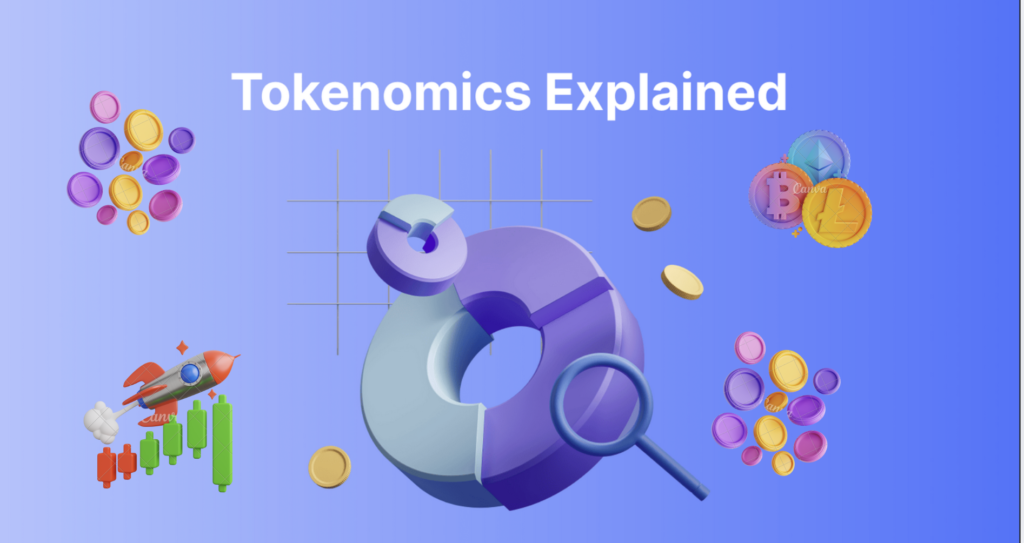In crypto, flashy marketing and viral memes may get a coin noticed, but solid tokenomics is what makes it last. It defines its behavior, value, and longevity. Yet, despite being one of the most important parts of any blockchain project, tokenomics is often misunderstood or ignored altogether.
At its core, tokenomics (short for token economics) is the set of rules, incentives, and mechanisms that govern how a token works within its ecosystem. It addresses key issues like how tokens are distributed and what they are used for. It outlines how scarcity is controlled and how stakeholders are incentivized to behave in ways that benefit the network. Therefore, its importance cannot be overestimated.
In this article we’ll break down the major components of tokenomics, show real world examples, what good tokenomics design looks like, and why mastering tokenomics is essential for builders, investors and users.
What Is Tokenomics?
Tokenomics is the blueprint for how a cryptocurrency works. It determines the supply, demand, distribution, and utility of a token. It is basically a summary of economic theory and strategic design guiding a crypto token ecosystem.
There are different types of tokens, each requiring different tokenomic models:
- Utility tokens: They grant access to products, services, or features on a platform. Think of them like arcade tokens or loyalty points.
- Governance tokens: These grant voting power over protocol decisions, upgrades, and treasury allocations.
- Security tokens: They are digital representations of real-world assets like stocks or bonds, regulated accordingly.
- Store of value tokens: Like Bitcoin, meant to retain value and resist inflation through scarcity.
In each case, tokenomics determines the token’s role, how it circulates, and how participants are rewarded or penalized for different behaviors. It informs everything from how projects grow to how communities form around them.
Core Components of Tokenomics
Let’s break down the key mechanics that make up a project’s tokenomics.
1. Token Supply Structure
- Total Supply: The maximum number of tokens that will ever exist. This could be fixed (like Bitcoin’s 21 million) or flexible, depending on governance.
- Circulating Supply: The number of tokens currently available in the market. This affects liquidity and price discovery and is a critical metric for valuation.
- Emission Rate: How fast new tokens are introduced. A fast emission rate can attract users early, but often leads to inflation concerns.
2. Inflationary vs. Deflationary Models
- Inflationary models introduce new tokens over time, which can fund ongoing development and reward participation.
- Deflationary models reduce supply, typically through burns or fees, to create upward price pressure.
- Some hybrid models adapt dynamically, burning in high-traffic periods and minting during quiet times.
3. Allocation & Distribution
This refers to how the token’s supply is allocated and distributed among the platform’s participants. When projects are transparent in this regard, they build trust and signal long-term thinking. Key metrics include:
- Team & Founders: Typically 10–25%, with long vesting periods to ensure commitment.
- Investors: Early backers usually receive tokens at a discount but are subject to lockups.
- Community & Airdrops: This Incentivizes early adopters, contributors, and ecosystem participants.
- Treasury: Usually reserved for future development, grants, and operational costs.
- Public Sale / IDO: Offers broader market participation, ideally with caps to prevent whales.
A well-structured distribution model avoids power centralization and reduces the likelihood of manipulation or insider dumping.
4. Vesting Schedules and Lockups
Vesting schedules are critical to prevent early insiders from flooding and damaging the market. Common vesting structures include:
- Cliff period: A delay period before tokens start to unlock.
- Linear vesting: Gradual release over time (e.g., monthly over 2 years).
- Back-loaded vesting: A system where more tokens are released later, to reward long-term commitment.
These mechanisms help stabilize token prices and align contributors with the project’s future.
5. Token Utility and Use Case
- Payments: Used for fees, transactions, or in-platform purchases.
- Staking: Locking tokens on the project’s platform for security or rewards.
- Governance: Proposing and voting on project decisions.
- Access: Unlocking premium features, content, or participation tiers.
The stronger and more diverse the utility, the more embedded the token becomes in the ecosystem, increasing its relevance and demand.
Real-World Examples of Tokenomics in Action
Ethereum (ETH)
- ETH is used to pay for transactions (gas fees), creating constant demand.
- With the transition to Proof of Stake and EIP-1559 burn mechanism, Ethereum now features deflationary pressure.
- This evolution demonstrates how tokenomics can adapt over time while reinforcing long-term value.
Axie Infinity (AXS and SLP)
- Dual-token model: AXS for governance/staking, SLP for in-game rewards.
- Poor SLP supply control led to hyperinflation and user exits as earnings dried up.
- This is a lesson on reward inflation and unsustainable growth mechanics.
Uniswap (UNI)
- UNI works only as a governance token.
- Despite no immediate use, it’s valuable because it governs one of DeFi’s largest protocols.
- It is a valid example of how governance and reputation anchors a token’s value.
Terra (LUNA/UST)
- LUNA was tied to UST, an algorithmic stablecoin, via a mint/burn mechanism.
- When UST lost confidence, the model imploded and created a death spiral.
- This shows that complexity without safeguards is a recipe for disaster.
Chainlink (LINK)
- LINK powers decentralized oracle networks on the Chainlink platform.
- As a reward token, tokens are issued to pay node operators and incentivize data integrity.
- This tokenomics is an example of utility-driven demand in a DeFi infrastructure layer.
Token Design – Behavioral Psychology For Crypto Projects
Tokenomics is as much about behavior as it is about supply and demand. Good token models use game theory to encourage holding (through staking, lockups, governance perks), promote network participation (by rewarding validators, contributors, and referrers), and disincentivize extraction (by implementing penalties for early withdrawals or low-quality participation)
When a crypto project implements solid tokenomics to guarantee its sustainability, it usually gains loyal communities. However, these policies must be thoughtfully considered before being implemented, if not, they might become nothing more than gimmicks.
Even good projects have failed due to bad tokenomics. Here are some mistakes that can mar a project’s long-term prospects:
- No Utility: If the token has no use case, it has no value.
- Unbalanced Allocation: Too high allocations for founders or early investors can lead to centralization and price suppression.
- No Vesting: Tokens that unlock immediately encourage profit-taking and undermine long-term value.
- Over-Inflated Rewards: Yield farming and staking incentives must be backed by real value or utility.
- Overengineering: Complex token models confuse users and erode trust.
- No Demand Drivers: If there’s no reason to buy or use the token, the hype will fade.
These mistakes often come from rushing to market or prioritizing hype over design. For a project to work, the tokenomics must be built in, not bolted on afterwards.
Therefore, if you are a crypto developer or founder and are looking to build something that lasts, anchor your token’s utility to core protocol functions. This gives investors reasons to buy and hold on to your tokens.
Also, be as transparent as possible with the community. This will build trust and get you a community that can die for your project. Lastly, design your project for longevity by incentivising positive behaviours and punishing negative actions. Keep in mind that projects that treat tokenomics as a living system do better than those that set it and forget it.
Conclusion
The tokenomics of a crypto project is one of its most important features. It doesn’t just move tokens, but also shapes user behavior, investor confidence, and long-term survival. When done right, tokenomics aligns incentives across all stakeholders and drives adoption and trust. When wrongly done, it can collapse the entire ecosystem, no matter how good the branding or how big the community. Whether you’re launching a project, investing in one, or just learning the ropes, pay attention to the tokenomics.


